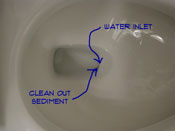 Another reason for a slow flushing toilet is a clogged inlet valve. The water from the tank is fed into the bowl via an inlet that is built into the porcelain bowl.
Another reason for a slow flushing toilet is a clogged inlet valve. The water from the tank is fed into the bowl via an inlet that is built into the porcelain bowl.
This might not be your problem, see 'How To Fix a Toilet' or 'Plumbing Repair' for all of the plumbing related articles.
Sediment can build up in this inlet. This will cause the water coming into the bowl to slow down. As a result the toilet will not flush correctly.
How a Toilet Works
Toilets are designed to create a siphonic action in the bottom of the bowl. A siphonic toilet uses a combination of water pressure and gravity to accmplish this. Since 1994, toilets in the United States can only use 1.6 gallons per flush. Not really a lot of water when you consider that some of the water gets used to clean the bowl and the balance is used to create the siphon, a water cyclone, to use an analogy.
There is an inlet at the very bottom of the bowl, that jets the water in to the outlet pipe to create the siphon. Over time, this inlet can build up with sediment. When this happens, the sediment needs to be cleaned out, or the toilet won't flush properly.
Even when the entire 1.6 gallons is used, if it does not get into the drain fast enough, you won't create a siphon. When this happens, you have what is commonly refered to as a 'Slow Flushing Toilet'.
Older toilets, with older toilets, the problem can be more pronounced. It may seem that with the extra water that an older toilet uses, that there is plenty to go around. However, this is not true.
For one thing, older toilets are, well, 'older' so the sediment has had a lot more time to build up, probably in locations you cannot readily see. The second thing is that older toilets were designed to use a certain amount of water, could be as much as 7 gallons per flush. If all of that water is not used in the proper amount of time, the toilet will flush poorly.
Safety Concerns
Toilets are somewhat dirty by nature. Even in the cleanest house, the dirtiest place is likely to be the toilet. Use gloves when working on or inspecting a toilet.
Disinfecting the toilet prior to any repairs or inspection is also a great idea. Dangerous bacteria can live in, even a seemingly clean toilts.
Where To Look for Sediment
There are several inlets for water in your toilet. Some of them are to rinse the bowl, but the biggest on is at the bottom and it is needed to create the siphon.
There are a series of small water inlets under the rim of the toilet bowl. You will need a mirror to be able to inspect them. They are small, but neccessary. The rinsing water also contributes to the siphonic action. If you see any discoloration or build up, this will need to be cleaned up.
As mentioned above, there is a larger inlet at the bottom of the bowl that creates a jet. This inlet is very important for the operation of the toilet. Again, you may need to use a mirror to inspect this inlet. Do you see any discoloration or build up? If you do, it needs to be removed.
Cleaning Out the Sediment
Some of the inlet holes are small so you will need something the can get inside them and break up the sediment.
You can use a small screwdriver or awl to clean out the sediment. It builds up over time and can be pretty stubborn. Try to get rid of as much of it as you can. Use a little elbow grease and get all of the sediment out of the inlet.
Use the mirror to keep checking on how well you are doing at getting the sediment cleaned out. Try to remove as much as you can.
Summary
Sediment takes a long time to build up. The negative results develop slowly, almost unnoticably over time. At some point the sediment becomes a big enough problem to keep your toilet from working. That is when you need to do something about it.
The toilet tank water level is another aspect of a slow flushing toilet. See the article 'Adjusting the Toilet Tank Water Level' for more information.

